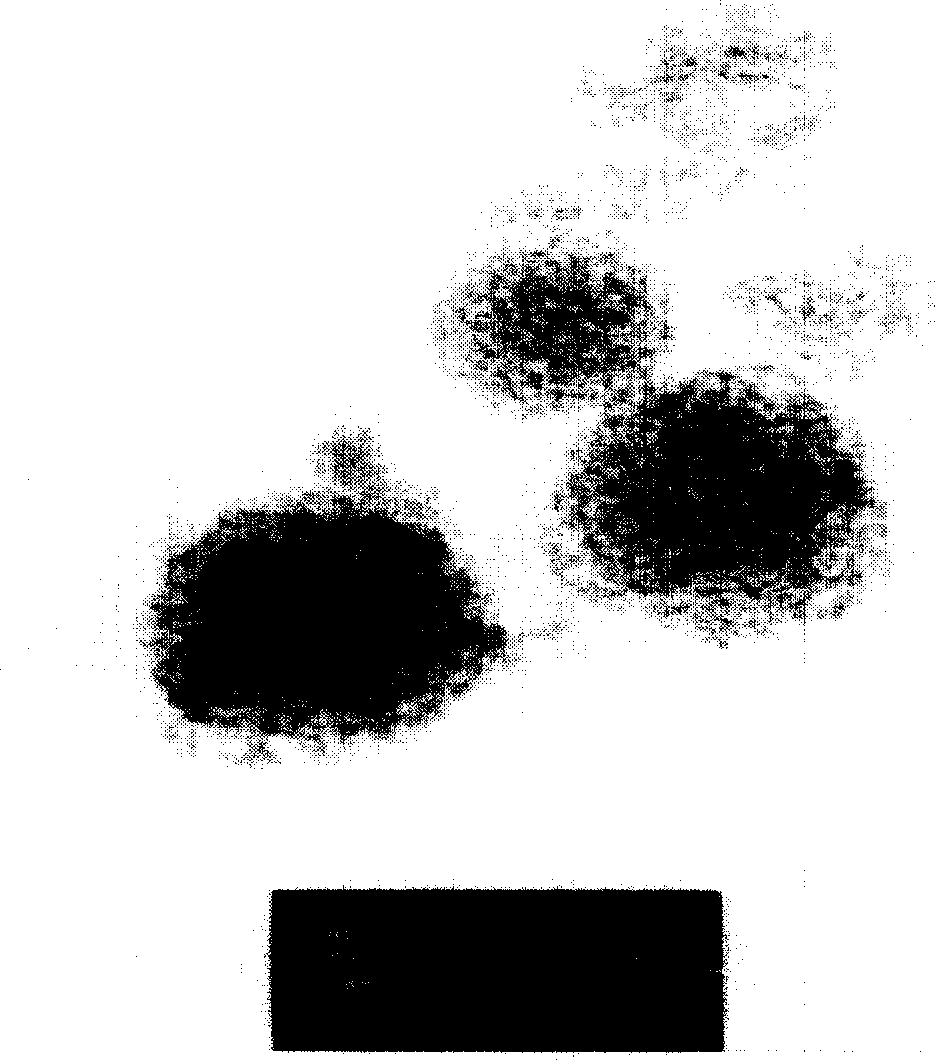Nano hydrogenation catalysts composition and method of producing the same
A technology of hydrogenation catalyst and composition, applied in chemical instruments and methods, metal/metal oxide/metal hydroxide catalyst, physical/chemical process catalyst, etc. issues such as narrow scope
- Summary
- Abstract
- Description
- Claims
- Application Information
AI Technical Summary
Problems solved by technology
Method used
Image
Examples
Embodiment 1
[0061] Mix 62g of second-line oil and 8g of SP-80, heat to dissolve at 80°C, and mix well; heat 300g of aluminum nitrate nonahydrate and 20g of nickel nitrate to melt at 80°C, add dropwise to the above mixture, and mix for 15 minutes to form a uniform superincrease Sol body, 114g titanium tetrachloride, 43g molybdenum pentachloride and 150g ethanol solution are added in above-mentioned micelle, and finally dropwise add the ammoniacal liquor 303g that weight concentration is 41% reaction 2 hours, aging 10 hours, obtains the hydrogenation catalyst of nanobody phase gel. The nano-hydrogenation catalyst gel was calcined at 300°C for 2 hours in a nitrogen atmosphere, and 550°C in a nitrogen atmosphere for 8 hours to obtain the nano-hydrogenation catalyst of this example. Its properties are as follows: BET specific surface: 320m 2 / g, pore volume: 0.52ml / g, average pore diameter: 12nm, average particle diameter: 32nm, pore volume with a pore diameter of 4-20nm accounts for 80% of th...
Embodiment 2
[0063] 52g minus four-line oil, 5g light deasphalted oil, 1g SP-60 and 2g lecithin were heated and dissolved at 100°C, and mixed uniformly; 505g aluminum nitrate nonahydrate, 180g silica sol (wherein containing silicon dioxide was 30wt%) , 90g of molybdenum tetrachloride and 55g of nickel sulfate were heated to 100°C to melt, added dropwise to the above mixture, and mixed for 30 minutes to form a uniform supersolubilized gel group. Under airtight conditions, 110g of ammonia gas was added to the above system at 100°C , carry out the precipitation reaction, and then aging for 20 hours to obtain the nanometer hydrogenation catalyst gel. The gel was calcined at 280°C for 2.5 hours by air, and then calcined at 580°C for 10 hours to obtain the nano hydrogenation catalyst gel of this example. Its properties are as follows: BET specific surface: 260m 2 / g, pore volume: 0.44ml / g, average pore diameter: 8nm, average particle diameter: 25nm, pore volume with a pore diameter of 4-20nm acc...
Embodiment 3
[0065] Heat and dissolve 265g of common three-line oil, 35g of minus three-line wax paste, 80g of polyisobutenyl diethylene glycol maleate, and 20g of tall oil amide at 120°C; mix 248g of aluminum chloride hexahydrate, 114g of titanium tetrachloride , 208g of urea, 20g of molybdenum trichloride hexahydrate and 10g of nickel nitrate were mixed and heated to 120°C for melting, added dropwise to the above mixture, and mixed for 20 minutes to form a uniform supersolubilized micelle. Seal the reactor, react at 80° C. for 4 hours, and age for 5 hours to obtain a nanobody phase hydrogenation catalyst gel. Blow the gel into air at 250°C for 2 hours, and then at 600°C for 5 hours to obtain the nano hydrogenation catalyst of this example, its properties are as follows: BET specific surface: 200m 2 / g, pore volume: 1.1ml / g, average pore diameter: 15nm, average particle diameter: 21nm, pore volume with a pore diameter of 4-20nm accounts for 92% of the total pore volume.
PUM
| Property | Measurement | Unit |
|---|---|---|
| Specific surface | aaaaa | aaaaa |
| Pore volume | aaaaa | aaaaa |
| Average pore size | aaaaa | aaaaa |
Abstract
Description
Claims
Application Information
 Login to View More
Login to View More - R&D
- Intellectual Property
- Life Sciences
- Materials
- Tech Scout
- Unparalleled Data Quality
- Higher Quality Content
- 60% Fewer Hallucinations
Browse by: Latest US Patents, China's latest patents, Technical Efficacy Thesaurus, Application Domain, Technology Topic, Popular Technical Reports.
© 2025 PatSnap. All rights reserved.Legal|Privacy policy|Modern Slavery Act Transparency Statement|Sitemap|About US| Contact US: help@patsnap.com

